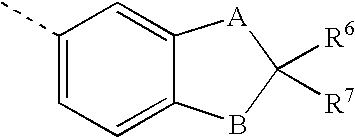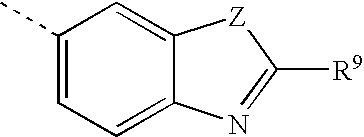Sulfonylalkanoylamino hydroxyethylamino sulfonamide retroviral protease inhibitors
a technology of hydroxyethylamino sulfonamide and retroviral protease inhibitor, which is applied in the direction of heterocyclic compound active ingredients, biocide, organic chemistry, etc., can solve the problem that the predictive value of compounds which are effective renin inhibitors is not good for effective hiv protease inhibition
- Summary
- Abstract
- Description
- Claims
- Application Information
AI Technical Summary
Problems solved by technology
Method used
Image
Examples
example 1
[0057]
Preparation of 2S-[Bis(phenylmethyl)amino]benzenepropanol
Method 1: 2S-[Bis(phenylmethyl)amino]benzenepropanol from the DIBAL Reduction of N,N-bis(phenylmethyl)-L-Phenylalanine phenylmethyl ester
Step 1:
[0058] A solution of L-phenylalanine (50.0 g, 0.302 mol) sodium hydroxide (24.2 g, 0.605 mol) and potassium carbonate (83.6 g, 0.605 mol) in water (500 mL) wa heated to 97° C. Benzyl bromide (108.5 mL, 0.605 then slowly added (addition time—25 min). The mixture was stirred at 97° C. for 30 minutes under a nitrogen atmosphere. The solution was cooled to room temperature and extracted with toluene (2×250 mL). The combined organic layers were washed with water and brine, dried over magnesium sulfate, filtered and concentrated to an oil. The identity of the product was confirmed as follows. Analytical TLC (10% ethyl acetate / hexane, silica gel) showed major component at Rf value=0.32 to be the desired tribenzylated compound, N,N-bis(phenylmethyl)-L-phenylalanine phenylmethyl ester...
example 2
[0061]
Preparation of 2S-[Bis(phenylmethyl)amino]benzenepropanaldehyde
Method 1:
[0062] 2S-[Bis(phenylmethyl)amino]benzene-propanol (200 g, 0.604 mol) was dissolved in triethylamine (300 mL, 2.15 mol). The mixture was cooled to 12° C. and a solution of sulfur trioxide / pyridine complex (380 g, 2.39 mol) in DMSO (1.6 L) was added at a rate to maintain the temperature between 8-17° C. (addition time—1.0 h). The solution was stirred at ambient temperature under a nitrogen atmosphere for 1.5 hour at which time the reaction was complete by TLC analysis (33% ethyl acetate / hexane, silica gel). The reaction mixture was cooled with ice water and quenched with 1.6 L of cold water (10-15° C.) over 45 minutes. The resultant solution was extracted with ethyl acetate (2.0 L), washed with 5% citric acid (2.0 L), and brine (2.2 L), dried over MgSO4 (280 g) and filtered. The solvent was removed on a rotary evaporator at 35-40° C. and then dried under vacuum to give 198.8 g of 2S-[Bis-(phenylmethyl)am...
example 3
[0067]
Preparation of N,N-dibenzyl-3(S)-amino-1,2-(S)-epoxy-4-phenylbutane
Method 1:
[0068] A solution of αS-[Bis(phenylmethyl)amino]benzene-propanaldehyde (191.7 g, 0.58 mol) and chloroiodomethane (56.4 mL, 0.77 mol) in tetrahydrofuran (1.8 L) was cooled to −30 to −35° C. (colder temperature such as −70° C. also worked well but warmer temperatures are more readily achieved in large scale operations) in a stainless steel reactor under a nitrogen atmosphere. A solution of n-butyl lithium in hexane (1.6 M, 365 mL, 0.58 mol) was then added at a rate that maintained the temperature below −25° C. After addition the mixture was stirred at −30 to −35° C. for 10 minutes. More additions of reagents were carried out in the following manner: (1) additional chloroiodomethane (17 mL) was added, followed by n-butyl lithium (110 mL) at 100%. Due to the relative instability of the product on silica gel, the crude product is usually used directly in the next step without purification). The diastereo...
PUM
| Property | Measurement | Unit |
|---|---|---|
| temperature | aaaaa | aaaaa |
| temperature | aaaaa | aaaaa |
| temperature | aaaaa | aaaaa |
Abstract
Description
Claims
Application Information
 Login to view more
Login to view more - R&D Engineer
- R&D Manager
- IP Professional
- Industry Leading Data Capabilities
- Powerful AI technology
- Patent DNA Extraction
Browse by: Latest US Patents, China's latest patents, Technical Efficacy Thesaurus, Application Domain, Technology Topic.
© 2024 PatSnap. All rights reserved.Legal|Privacy policy|Modern Slavery Act Transparency Statement|Sitemap



